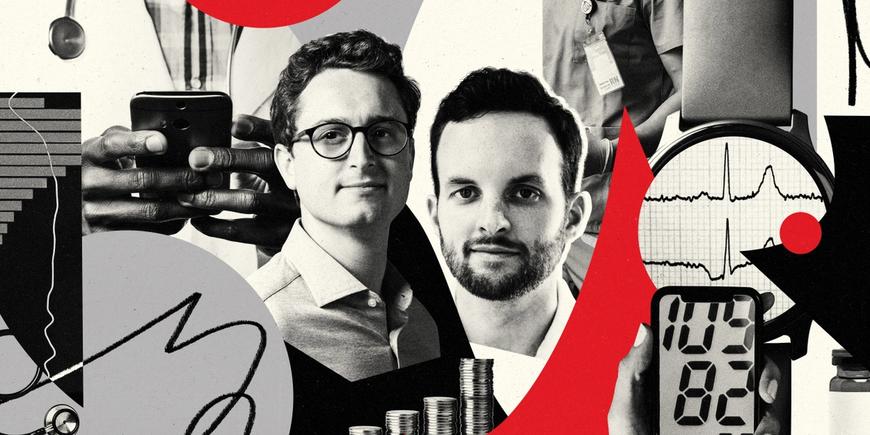Primary’s Lens on Digital Health
An inside look at the trends Primary Venture Partners’ healthcare investment leads Jason Shuman and Sam Toole are watching most closely.

2020 was a year for the history books. A global pandemic upended our day-to-day lives and pushed our healthcare system to its breaking point more than any other event has in living history. Now more than halfway through 2021, it’s clear that there is still a ton of work to do before we get back to “normal.”
Here at Primary we have been believers in the digitization of healthcare for quite some time, as early investors in K Health , Alma, Stellar Health, and many others. Although the healthcare ecosystem has been slow to adopt new technologies in the past, we are at the precipice of a true digital health evolution. We’re ten-plus years into the wide-spread adoption of EHRs and the introduction of value based care; COVID-19 has pulled forward the regulatory environment in new and exciting ways; and telehealth adoption has exploded. Add in the fact that more tech-first healthcare talent that grew up during the early days of Oscar, Ro, Flatiron, and others is flooding the market, and it’s hard not to be excited about the potential for change in America and NYC’s healthcare scenes.
Given this opportunity and Primary’s dedication to backing the best early stage healthcare businesses, this piece is the first of a series of posts that will highlight some of our theses and favorite themes in various parts of the healthcare world. With these posts we plan on sharing our frameworks for evaluating specific investments, advice, and the stories behind some of New York’s top healthcare companies. To help set that stage, we’ve outlined a few specific areas that we’re particularly excited about.
In case this is not abundantly clear, if you are working on something in any of these areas, we want to speak with you!
Of course, this is not an exhaustive list and if you’re a founder building in a different part of the massive healthcare system, we still want to hear from you.
And don't miss the rest of this series, which includes Jason's framework for evaluating telehealth investments, top advice from successful NYC founders, guidance on north star metrics, and an in-depth founder interview series.
More direct to consumer “niche” telehealth and hybrid care businesses
As we all know, the past year has seen a massive acceleration of telehealth adoption—increasing from 0.3% of provider visits in 2019 to 23.6% in 2020. Although we are starting to see these numbers normalize (stabilizing around 17% of all outpatient visits since June 2020), it’s clear that behaviors have changed and the regulatory environment will likely look at telehealth more favorably. Over the past decade, we’ve seen an explosion of telehealth businesses focusing on the primary care layer (K Health, 98point6, Teladoc), while others have leveraged direct relationships with patients to help with specific conditions/diseases (Ro, Cerebral, Hims/Hers).
With the above in mind, we are increasingly excited to see more niche-focused direct-to-consumer telehealth businesses that are laser focused on providing care to a very specific patient population or more narrow disease/condition than traditionally tackled. We believe that there will be multiple billion dollar businesses built in markets that might look “too small” at first blush, especially around chronic conditions. For these businesses, it is likely that a more holistic care model (telehealth and in-person) with multiple types of providers will need to be involved to improve patients’ experiences. Although this adds operational complexity and additional cost to the business, it will be a requirement to improve patient outcomes in the long term. We’re already seeing this emerge with businesses like Allara (PCOS), Perry Health* (Diabetes), and Calibrate (Weight Loss) and expect to see many more in the years.
*indicates a Primary Portfolio business.
A continued shift toward risk bearing models
Despite it being 14 years since the concept of value based care was originally introduced and nine years since Obamacare was passed, we’re still in the early days of value based care (VBS). While 84% of hospitals report participating in value-based care, many organizations still derive a majority of their revenue from fee-for-service contracts rather than value-based contracts.
In the V1 of managed care, many of the major cost centers of the healthcare system (mental health, musculoskeletal, diabetes, heart disease) were tackled on the self-insured employer side, while other big winners have emerged in the vertically integrated value based care world with specific patient populations (Oak Street Health, Landmark Health/Iora Health, Cityblock). Meanwhile, businesses like Aledade and Stellar Health*, have focused on helping the existing medical system shift behaviors towards value based care. As the payer and employer universe continues to develop and embrace VBS, we believe there will continue to be real opportunities to build new business models that create more alignment in regards to risk and better integrate technology to do so.
We are excited to see more full stack healthcare businesses that deliver care and tackle conditions and diseases with the goal of bearing risk from Day 1. Despite this being a challenging goal, we expect to see entrepreneurs start to build their businesses a bit differently—even if it’s more capital intensive to start as they take a hybrid care approach. Opportunities feel especially exciting when we look at higher acuity patients, complex populations, and patients suffering chronic conditions. From the conversations we’ve had to date with businesses like Vori, Equip, and others, these businesses are often founded with the mindset of truly bending the cost curve from Day 1, they think deeply around attribution, and are actively making longer-term investments to change patient outcomes.
A demand for more personalization
Today, healthcare is still mainly a one-size-fits-all market when we look at the digital health world. But, we know that there is the potential to deliver an integrated and personalized care experience to consumers while also improving outcomes by empowering providers. If Nike can provide a highly customized marketing and shopping experience, why can’t a medical provider? Given the foundation laid by the EHRs and a push towards interoperability, we believe we are at the renaissance of application layer software for healthcare.
Further extending the ecommerce analogy, we think there are countless opportunities to expand the enablement software layer and optimize patient experience in order to deliver more integrated and personalized care across the spectrum. We’re already seeing this in the provider world and pharma with businesses like Weave, Courier Health, and Pager, but there is still a lot of room to run. These companies could take on multiple formats and may even look a bit like “marketing tech” at first blush (re-marketing, re-engagement, etc), but we are confident they will improve outcomes long-term.
Infrastructure, connective tissue, and data
With the foundation of EHR’s ~10 years old today and ongoing shifts in the regulatory environment that promote interoperability, we are incredibly excited by businesses that focus on building or rebuilding healthcare’s infrastructure. Similar to fintech five years ago, when businesses started to be able to sell to the Brexs, Ramps, Chimes of the world versus traditional banks, healthcare infrastructure businesses can now sell to the Hinges, Livongos, and Oscars versus traditional healthcare providers.
We have already made large strides on the data and analytics end of healthcare, especially in pharma. But there are so many opportunities to help improve each underlying part of the healthcare journey and replace old-school parts of the healthcare stack (i.e. pen, paper, and faxes) — and we couldn’t be more excited by this. By unlocking siloed healthcare data, we know we can improve steerage, enable payers to run more efficiently, and help doctors provide the right care to patients, while simultaneously making it easier to build the healthcare businesses of the future. This modern healthcare stack is starting to take shape with businesses like Cohere Health (prior authorization), Nomad Health (staffing), Flume Health* (TPA as a Service), Redox (EHR integration), Capital RX (drug pricing), Wheel (providers as a service), Dandelion Health* (Clinical Training Data) and many others. As health organizations become more digitally savvy and the future healthcare unicorns are born, these companies and others like it will be key to their success.
Continued unbundling and expansion of the hospital
In the past, health systems have greatly benefitted from investing in alternative sites of care beyond the hospital. This makes sense—it lowers costs, improves patient experience, and hopefully enhances the quality of services provided. As consumers increasingly adopt telehealth and leverage connected devices and payers/providers align on the value of the social determinants of health, we expect to see a continued explosion of care outside of the hospital.
With the original unbundling kicked off by the growth of urgent care centers like CityMD and then expanded by companies like OneMedical, we are now seeing companies focus on “meeting” the patient directly in their homes, while payers expand the definition of “care.” As we look at business in this space, we are particularly excited by companies that help shift care models from episodic to continuous and those that empower the patient to better own their long-term health. In some cases, this could mean delivering care directly to the home (Dispatch Health), while in others it’s about further empowering the patient to better care for themselves (Everlywell, LetsGetChecked). Coupled with value-based care and Medicare Advantage initiatives that tackle food insecurity (Project Well), loneliness (Papa), or aging in place (Jukebox Health*), it’s clear that there is a real appetite across the spectrum to change how patients receive care.
Fintech for healthcare
Medical debt has widely been recognized as the number one cause of bankruptcies in the U.S., and the unfortunate reality is that this is not driven by lack of insurance. In fact, 90% of adults with medical debt have at least basic health insurance. This is an issue that urgently needs innovative solutions, and the revolution that we have seen happen in fintech is beginning to disrupt healthcare, enabling patients to better afford care or manage payment for care and providing intermediaries with the tools to reduce cost of care.
Within this intersection, we’ve seen an explosion in health-focused savings and financing vehicles (First Dollar, PayZen, Paytient) as well as payment platforms working with health systems, consumers, and employers (Cedar, Papaya, Wellpay). Unlike fintech where point solutions abound, healthcare requires full-stack solutions that facilitate interoperability across EHRs and integration across revenue management and insurance processes—it’s not an easy task to solve. However, we’re excited to see companies attack this part of the market because those that can strike this balance will have a remarkable impact on the patient experience and construct a formidable moat in the process.
---
As we hope to have illustrated with this post, we’re strongly dedicated to finding the next big early stage startups in NYC healthcare. In the coming weeks we hope that our investment theses, investment evaluation frameworks, and interviews with top founders—which you can find here—will provide the ecosystem with some shared information and knowledge that will help you on your journey to making an impact on one of the most critical industries in our world.
And thank you to all of the people who helped with this post and shaped our thinking: Sneha Kasuganti, Harry Ritter, Alexi Nazem, Michael Meng, Florian Otto, Ryan Grant, Emily Melton, Allon Bloch, Zachariah Reitano, Carolyn Witte, Isabelle Kenyon, Rachel Blank, Gene Kakaulin, Pan Chaudhury, Saad Alam, Guillaume Cohen-Skalli, Rick Doblin, Dr. Jill Blakeway, Lulu Ge, Avi Dorfman, Anna Fagin, Sean Doolan, Nimi Katragadda, Brett Cook, George Ribaroff, and Saeju Jeong.

